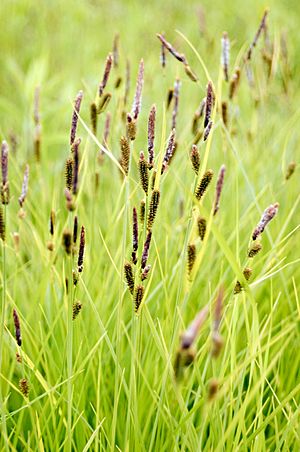Upright sedge facts for kids
Quick facts for kids Upright sedge |
|
|---|---|
 |
|
| Conservation status | |
| Scientific classification | |
| Genus: |
Carex
|
| Species: |
stricta
|
| Synonyms | |
|
|
Carex stricta, also known as upright sedge or tussock sedge, is a type of sedge plant. It looks a lot like grass, which can make it tricky to spot among other plants. It has long, green stems that are shaped like a triangle.
This plant loves wet places! You can find it growing in marshes, forests, and right next to water bodies like rivers and lakes. It can grow to be about 2 feet (0.61 m) tall and 2 feet (0.61 m) wide. A cool thing about this plant is how it gets its common name, "tussock sedge." When its old leaves die, they pile up around the living plant, forming a big, dense clump called a "tussock." This plant is very common in eastern North America, especially in wet areas east of the Great Plains.
Contents
How Tussock Sedge Reproduces
Tussock sedge has a few ways to make new plants. Its tiny seeds are light enough to be carried by the wind, spreading them to new spots.
Seeds and Animals
When the seeds land, they become a tasty snack for many animals. Birds like the dark-eyed junco, northern cardinal, wild turkey, and different kinds of ducks (like mallards and wood ducks) love to eat them. Small mammals, such as squirrels, also enjoy munching on these seeds.
Vegetative Reproduction
Besides seeds, tussock sedge can also make new plants using a process called vegetative reproduction. It does this with special underground stems called rhizomes. These rhizomes spread out and can grow new plants, often forming large groups or colonies of tussock sedge.
Tussock Sedge and Insects
This plant is also an important home for certain insect larvae (which are like baby insects). It acts as a "host plant" for the larvae of three different types of butterflies or moths:
- The black dash
- The dun skipper
- The eyed brown
These insects depend on the tussock sedge for food and shelter when they are young.
Images for kids



